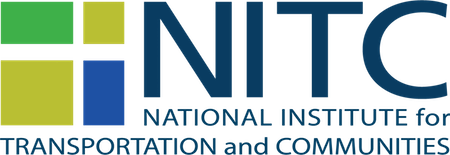266 Results
Automated Detection, Tracking, and Safety Analysis of Pedestrians and Cyclists Using YOLOv9
Banafsheh Rekabdar
Sirisha Kothuri , Nathan McNeil
This applied research project aims to adapt and further train YOLOv9 to enhance its ability to accurately detect, track, and count cyclists and pedestrians in video data from the Portland Metro Area. The method will also extract surrogate safety metr ...
Read More
Exploring Bike Bus Programs in the United States
John MacArthur
Nathan McNeil
Photo by Jonathan Maus, BikePortland
The trip to and from school is made by nearly every child in Oregon every school day. Bike and walk buses, or organized groups of school children, parents, and ride/walk leaders, seek to encourage biking and wa ...
Read More
Mobility and Accessibility Resilience of Transportation Infrastructures
David Yang
The objective is to address practical challenges related to mobility and accessibility following natural disasters. The anticipated outcome of this project will be to provide actionable insights and solutions that can be implemented in real-world tra ...
Read More
Examining the Geotechnical Earthquake Hazard to Transportation Assets in Oregon and Washington: Characterizing Earthquake-Induced Deformations of Silt Soils
Diane Moug
Critical transportation infrastructure in Washington and Oregon is vulnerable to damage during strong earthquake shaking, including the anticipated magnitude 9 Cascadia Subduction Zone event. A major hazard to transportation infrastructure is the fai ...
Read More
Working Towards Operationalizing Equity into the Research Process
Aaron Golub
While our researchers are experts in various aspects of transportation research, not all researchers have the tools to address equity topics in their research or conduct their work following good equity practices, ranging from data collection and ana ...
Read More
Exploring the Use of Crowdsourced Data Sources for Pedestrian Count Estimations
Sirisha Kothuri
Nathan McNeil , Kate Hyun , Stephen Mattingly
Counts provide the foundation for measuring nonmotorized travel along a link or a network and are also useful for monitoring trends, planning new infrastructure, and for conducting safety, health, and economic analyses. For safety analysis, they are ...
Read More
Toward Automating the Measurement of Urban Design Qualities Related to Walkability
S. Hassan Ameli
Streets are one of the most significant elements of urban spaces to accommodate public activity and provide access to numerous locations and services. Today, our cities face various challenges, including urban sprawl, air pollution, and obesity. To ...
Read More
Housing Choice, Transportation Equity, and Access to Opportunities in Refugee and Immigrant Communities
Diane Mitschke
Anne Nordberg , Stephen Mattingly
Mobility directly impacts access to opportunities for all protected classes; however, transportation planning and public transit agencies and housing authorities rarely coordinate affordable housing and the transportation system planning decisions. T ...
Read More
Understanding Travel Behavior and Accessibility for Older Adults: A Comprehensive Framework
E-Sok Andy Hong
Xiaoyue Cathy Liu
Accessibility plays a fundamental role in the day-to-day lives of individuals. However, the COVID-19 pandemic has highlighted the gross inequality in older people’s accessibility to health care and essential services. Months of staying inside, with ...
Read More
Understanding Connections Between Mobility, Transportation, And Quality Of Life In Refugee Communities In Tucson, Arizona
Orhon Myadar
Nicole Iroz-Elardo , Arlie Adkins , Maia Ingram
Refugee issues have been brought to the forefront of political and public debate in recent years. Although historically the U.S. has resettled more refugees than any other country, the refugee admission cap has dropped to the lowest since the enactme ...
Read More
App-based Data Collection to Characterize Latent Transportation Demand within Marginalized and Underserved Populations
Noelle Fields
Stephen Mattingly , David Levine , Nicole Iroz-Elardo , Courtney Cronley
This interdisciplinary, multi-site, technology transferability study will advance innovative methods in travel data collection and improve the quality of data designed to show latent travel demand, as well as the impacts of mobility on the physical, ...
Read More
Rural Gentrification and the Spillover Effect: Integrated Transportation, Housing, and Land Use Challenges and Strategies in Gateway Communities
Danya Rumore
Philip Stoker
Small towns and cities near national parks, public lands, and other natural amenities throughout the west are experiencing rapid growth and increased visitation. These “gateway communities” comprise a significant portion of the rural west, consti ...
Read More
Page 1 of 23
Next ›
